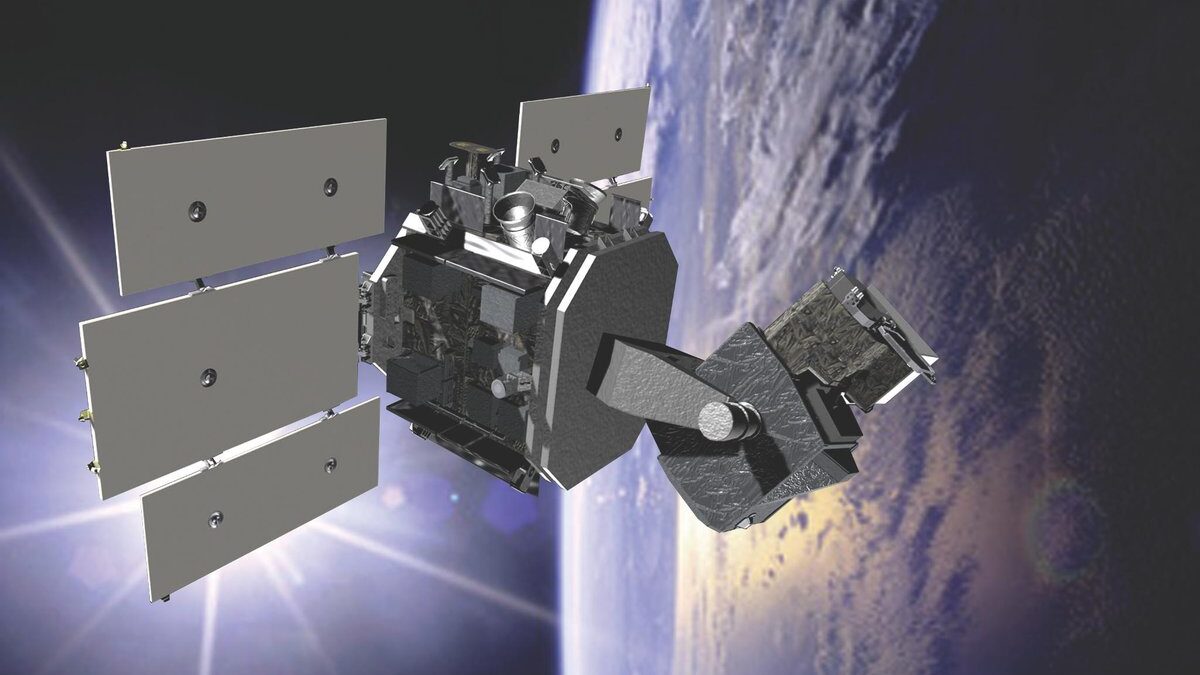Secretive ‘SILENTBARKER’ sats to launch late summer as space monitoring demands grow

Space Command wants more space-based telescopes, such as the aging Space-Based Surveillance System (SSBS), to keep tabs on the heavens. (Image: Boeing)
SPACE SYMPOSIUM — The National Reconnaissance Office and the Space Force now plan to launch the first satellites in their highly classified joint SILENTBARKER program to improve monitoring of the heavens this summer, according to NRO Director Chris Scolese.
The new capability no doubt will be welcomed by leaders at US Space Command, who have been increasingly frustrated about the Defense Department’s failure to fix gaps in space domain awareness (SDA) capabilities required to keep real-time tabs on adversary space activities.
Meanwhile, the Government Accountability Office (GAO), in a report released on Monday, is pushing the Space Force to move faster to integrate commercial SDA capabilities in order to fill some of those blind spots — which “include gaps in the geographical distribution of global sensors that collect data and limited sensor capability for objects in deep space.”
Speaking at the Space Foundation’s annual Space Symposium in Colorado Springs on April 18, Scolese for the first time disclosed two salient details about the NRO-led cooperative program: that the constellation will include “more than one” satellite, and it will be keeping eyes on space objects in geosynchronous orbit (GEO) where most critical national security satellites currently are stationed.
Further, he said, NRO and the Space Force “will be launching the SILENTBARKER vehicles later this summer.”
The spy satellite agency and the Pentagon have been tight-lipped about SILENTBARKER since its inception in December 2017. An initial request for proposals in January 2018 targeted launch in 2022, and in February 2019, the Space Force’s predecessor, Air Force Space Command, contracted with United Launch Alliance under the Evolved Expendable Launch Vehicle program (now called the National Security Space Launch program) for launch from Cape Canaveral.
According to Space Force budget request materials for fiscal 2023 and 2024, the collaborative effort is designed “to minimize the space-based SDA gap” after the Space Based Space Surveillance (SBSS) Block 10 satellites go dark, anticipated in 2028, and help protect “high value assets in space.”
SILENTBARKER falls under an umbrella research and development budget line called “PE 1206425SF / Space Situation Awareness Systems,” which in the FY24 request was rejiggered to include both ground and space-based projects [PDF].
“The Space Force is partnered with the NRO on SILENTBARKER space segment and telemetry, tracking, and commanding (TT&C) program segments,” the FY24 documents read. “Mutual investment for the non-recurring engineering (NRE) cost enables the potential for a larger initial constellation buy and lower unit costs. SILENTBARKER expansion contract was awarded Jun[e] 2021 to extend capabilities past [initial operational capability],” which is projected to be reached in FY24.
The FY24 budget justification documents also show that a previously planned Space Force program, which was included the FY23 budget request [PDF], to build a separate SBSS follow-on has been scrapped in favor of SILENTBARKER and the complementary acquisition strategy.
That umbrella budget line also includes funds for an “expansion” of SILENT BARKER, complemented by wider efforts to pursue hosted payloads on commercial and “international partner” satellites and efforts at Air Force Research Laboratory to develop satellite systems to monitor cislunar space.
The Space Force asked for $105.1 million for PE 1206425SF in FY23, but received only $96.9 million. It asked for $115.6 million in FY24.
The FY24 budget documents also reveal that the Space Force’s actual investment in SILENTBARKER is low and concentrated on supporting launch.
“The Space Based SDA SILENTBARKER project has very minimal organic Space Force resources. The FY 2024 Management Services includes support to parallel efforts for both the SILENTBARKER Baseline and Expansion, including Space Force contributions for prepare for SILENTBARKER launch, check out, and on-orbit support as well as design reviews for SILENTBARKER Expansion.”
According to the budget documents, data will flow to the Intelligence Community and military users via SPACECOM’s Combined Space Operations Center and the joint SPACECOM-NRO National Defense Space Center.
To feed those centers, funding in the umbrella budget line covers Space Force “implementation of mission data processing and data dissemination efforts supporting SILENTBARKER and other SDA prototyping efforts.”
Integration of SDA data into computer processing and information dissemination networks has been a long-running struggle for the Space Force, and the lack of modernized software systems also is highlighted by the new GAO report as a bugaboo for the service’s ability to take advantage of the growing amount of commercially provided observation data.
“The Space Force’s Unified Data Library (UDL) is a cloud-based data repository designed to consolidate commercial and U.S. government SSA data, as well as data from other countries,” GAO explains. “The Space Force has deployed an initial operational version of the UDL and plans to further develop it; however, staff who monitor objects in space are not using it in daily SSA operations because it is not integrated into their operational systems.”
The congressional watchdog agency recommends that the service develop a plan on how to do so.
GAO also urges the Space Force to come up with an overarching plan for “comprehensively” evaluating, on a routine basis, what commercial data is available to augment Defense Department-owned ground- and space-based telescope and radar systems, and how to use licensing agreements to get access.
“Establishing a process to regularly identify and evaluate commercial SSA data would better position the Space Force to meet its growing need to identify and characterize space objects,” the GAO report, called “Space Situational Awareness: DOD Should Evaluate How It Can Use Commercial Data,” says.